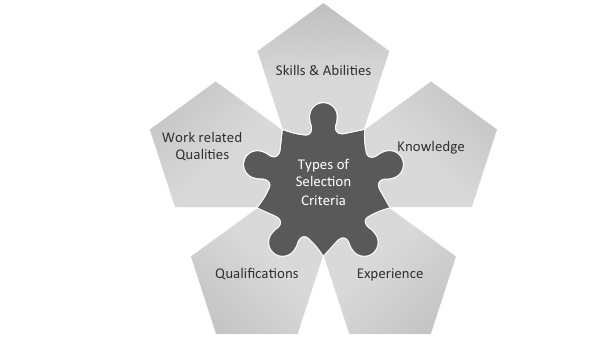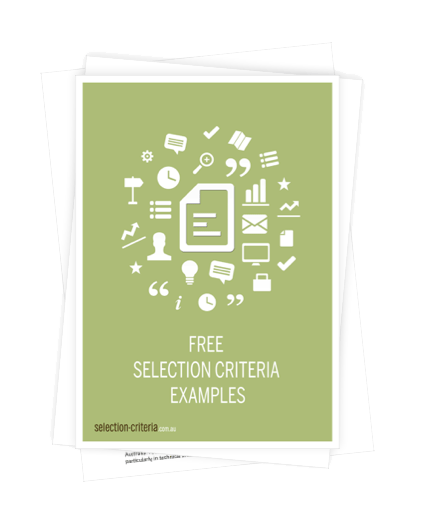Addressing key selection criteria (or KSC) is an unfortunate but necessary part of a government job application.
What you will find on this page:
What Are Selection Criteria?
Selection criteria summarise of the key skills, abilities, knowledge, experience, qualifications and work-related qualities that a position requires. They are closely related to the job description and will reflect the exact requirements listed in the job description.
- They generally come in the form of statements; however, they can also be just a list of competencies. (See the competency frameworks section for more information and examples of their use).
- They are found in most government job ads, and applicants are asked to write statements addressing them or cover letters that show the applicant meets the selection criteria.
- They let each applicant know how they will be assessed. The method of selecting an applicant for a job is highly transparent as you will know what the selection panel are looking for.
- They are used to assess written applications, and they are also used in government job interviews.
- From an applicant's perspective, they are time-consuming and confusing, and addressing them is the most frustrating part of their job application.
A few extra points to note:
1. In a written job application, the selection criteria statements are used to shortlist applicants and decide who will move onto an interview.
2. Your written statements addressing the selection criteria are typically given more weight than your resume, so the best way to secure a government interview is to have solid written statements.
3. Selection criteria appear again during the government interview stage, where the interview questions will be based on the selection criteria.
How to Address Selection Criteria
Addressing selection criteria is essentially like writing an essay. You are showing the selection criteria that you have the necessary skills and abilities, knowledge, experience, qualification and/or work-related qualities needed in the job you are applying for. While you can also include this information in your resume, your statements addressing the criteria should be a separate document written in a more narrative style.
The criteria that you need to address are outlined in the selection documentation or position description. Sometimes they might be called "key accountabilities", "key attributes", "claims for the position", or "capabilities", but these are substantially the same thing with the same purpose; to identify the requirements of the job and the best person for the job.
Panels have the right to remove from the shortlist any applicants who have not sufficiently addressed the criteria. If you don’t address them or only include a brief, non-convincing paragraph, your application may not even get looked at. (Statements should be close to three-quarters of a page in length per selection criteria unless a word limit is stated in the selection documentation).
Use Our Free Selection Criteria Examples
See how selection criteria statements are written, what they include and how they are formatted.
Download our free selection criteria examples here.
Different Types of Selection Criteria
The 5 Categories of Selection Criteria
More important than being essential or desirable is the fact that every selection criteria will fall into one of five categories, and which category they fall into will affect how you should address it. It is vital that you know what kind of criteria you are addressing and what information you should be providing. These categories are:
- Skills and abilities
- Knowledge
- Experience
- Qualifications
- Work-related qualities

Skills & Abilities
How do the skills that you have, relate to those required in the
position?
What skills do you have that are transferable to the position?
How have you gone about improving your skills in the past?
Have you reached a specific proficiency level?
Provide a few examples of your skills and abilities in action.
Knowledge
Where did you get your knowledge?
How is your understanding relevant to the position?
How would you apply your understanding in the position?
How do you continuously improve and build upon your knowledge?
Experience
Where did you gain your experience?
How much experience do you have?
What is the quality of your experience?
How has this experience benefited your current employer?
Provide a few examples of your experience in action.
Qualifications
A paragraph stating your qualification and where and when it was obtained is generally sufficient. If the criterion has not been specific regarding the qualification required, e.g. “a qualification in social sciences,” it is best to add an additional paragraph describing how your qualification is relevant to the position or outline any major areas of study that are beneficial for the position or work area.
Work-Related Qualities
Work-related qualities can include things like initiative,
motivation, commitment to a set of workplace values, a code of ethics,
or a code of conduct. Address this criterion as you would the
skills and abilities criterion, and if a criterion asks for your
commitment, provide examples of how you commit to the principle.
Essential or Desirable
Often criteria are advertised as either 'essential' or 'desirable'. But, from an applicant's perspective, this shouldn't make any difference to how you address them in your job application. You should address all selection criteria as if they are essential. Follow our tips here if you don't meet the selection criteria.
Competency Frameworks
As mentioned above, criteria usually come in the form of statements, but they can also be a list of competencies, particularly when a competency framework is used. Some examples of competency frameworks are:
- The Australian Public Service (APS) Integrated Leadership System,
- The NSW Capability Framework
- The QLD Leadership Competencies
- The Victorian Public Service Capability Framework
- The WA Public Sector Capability Profiles
(This is not an exhaustive list, there are many different capability frameworks used across the states and within local government, including departmental specific frameworks).
A Statement May Look Like This
“The demonstrated ability to achieve results in a team
environment.”
"The demonstrated ability to communicate effectively both orally and in writing."
"The ability to support and cultivate productive working relationships", etc.
A Competency May Look Like This
1. Achieve Results
• identifies resources and uses them appropriately
• builds and applies expert knowledge
• responds constructively in an environment subject to change
• takes responsibility for managing workflow, timelines and
deliverables in order to achieve results
Or, a competency might just be a list like this:
Attention to detail
Interpersonal skills
Communicate with influence
Initiative and flexibility
Organisational skills, etc.
How to Address Competencies
We receive lots of questions from applicants wanting to know how they should address these competencies. And the answer is very simple. When you are addressing selection criteria, whether you have to respond to a statement or a competency framework/statement, it is important to remember:
- The method for writing your statements is exactly the same as addressing "regular" criteria;
- The way you will be assessed is exactly the same;
- The only difference is how the statement is worded and how the selection panel have come up with the criteria/competencies that they want you to address.
The Key to Addressing Selection Criteria
The key to excellent selection criteria is focussing on hard skills that you can prove. Saying that you can do something is not enough. You need to demonstrate it. And present it in a way that a panel member (who is reading quickly through 30 other applications) can absorb quickly, take notice of, and remember.
Let us take the interview stage as an example. You may notice in a job interview that a lot of the questions will start like:
"Tell me about a time when..." or
"Give me an example of..."
The interviewer wants to know about specific examples of when you have used the skills, experience or knowledge that they are questioning you about.
You can write about the same sort of things in your job application when addressing selection criteria. Write about examples of your skills in action. Tell the panel about specific instances where you have experienced something or grown in your knowledge. This is what the interview panel really want to know about and you can make your statements stand out.
If you do this, you are providing the selection panel with evidence-based selection criteria responses.
Evidence-Based Selection Criteria
You may have heard the term "evidence-based criteria" and wonder what it means.
It means that when a selection panel reviews your written job application or interview performance, they are looking for evidence that you have met their requirements.
They do not care how much you know about a topic (unless it is a knowledge-based selection criterion) or how good you say you are. They want evidence that you can substantiate your claims.
It is up to you to provide evidence that you meet the KSC and the best way to do this is to give lots of examples from your experience and work history.
Even in the case of knowledge-based selection criteria, you should be putting your knowledge into a work context and explaining how you have come about this knowledge and how you use it. Anyone can copy information from a textbook!
How to Make Your Statements Stand Out
To make your written application stand out against the rest, you should go into the job application process assuming that all applicants are well qualified for the job and make your application the marketing document that describes: why your skills are the most relevant; why your experience is the most beneficial; why your understanding is the most developed; and why you have the best personal qualities for the position.
Need to Know More?
Our book Selection Criteria Coach contains over 150 pages of information, tools and templates to make your selection criteria quick and easy to write.
Common Questions
- How long should my statements be?
- How can I write great selection criteria when the application is due tomorrow?
- How can I make my selection criteria examples stand out?
- Can I get someone else to write my criteria for me?
- Should I still apply for the job if I don't meet all of the criteria?
- What is the STAR method and how do I use it?

